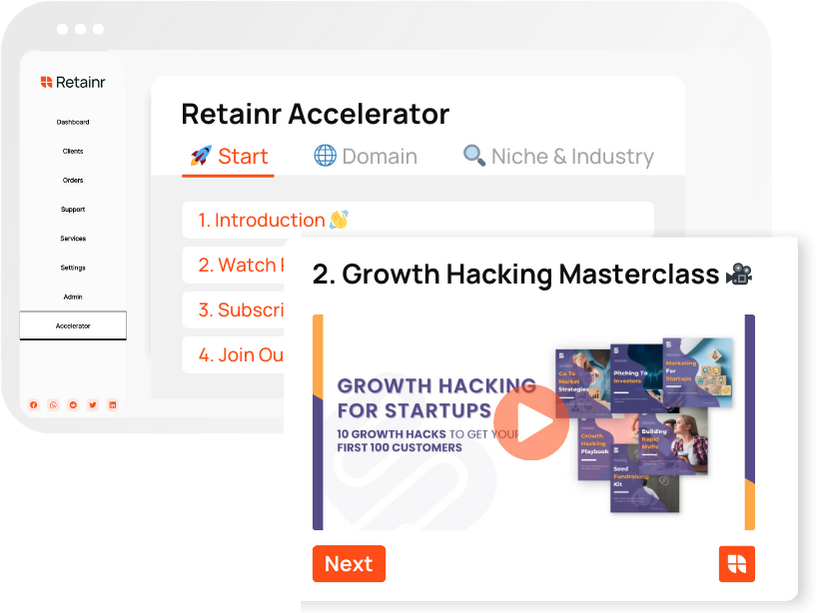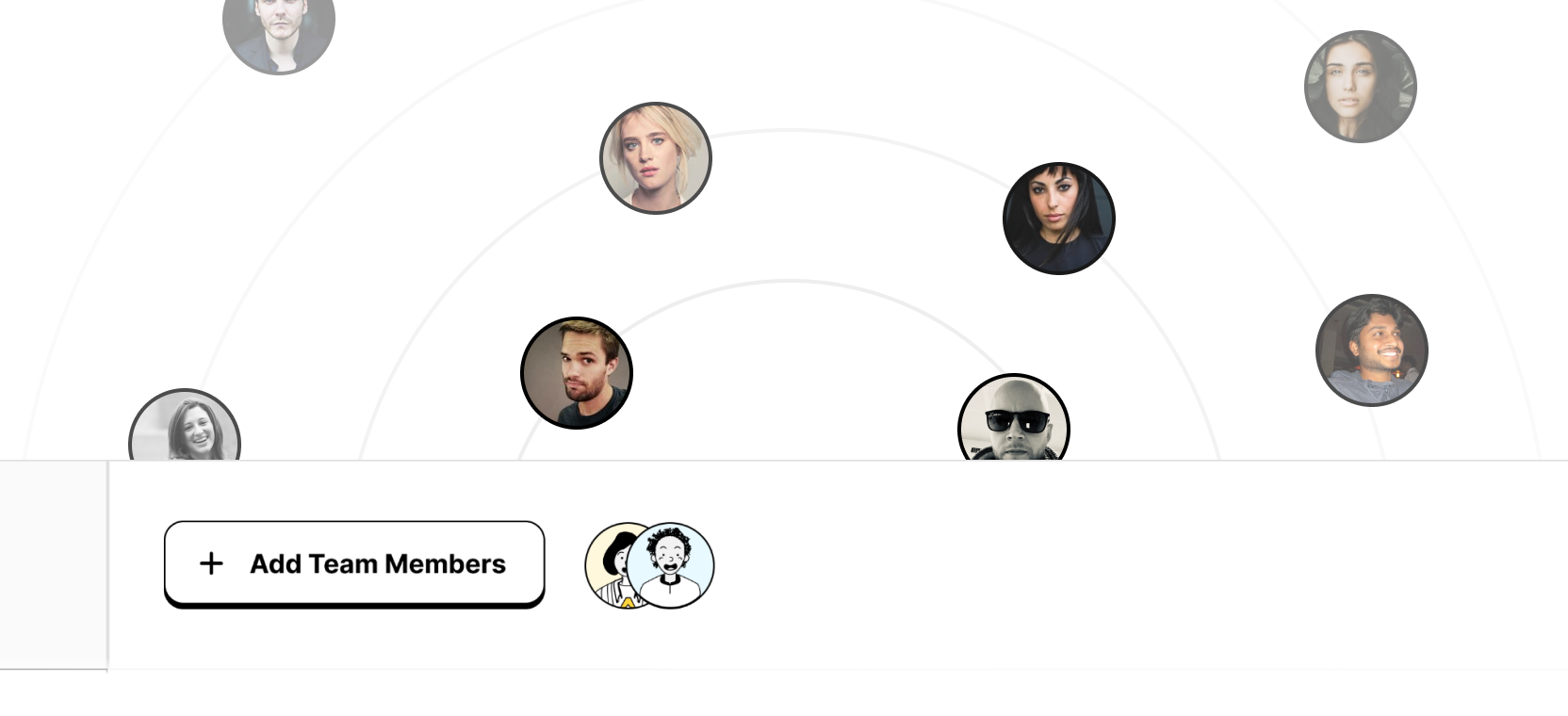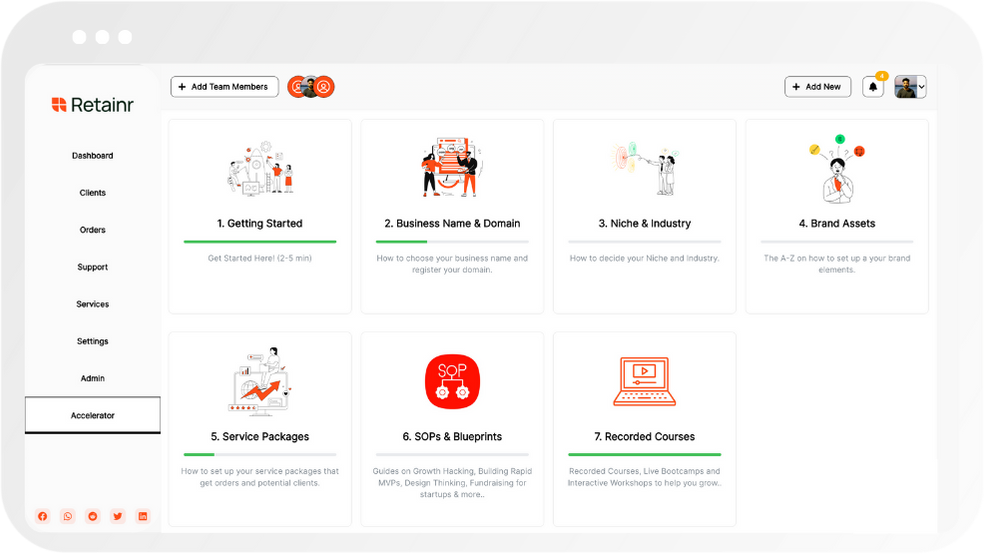
How to Streamline Project Management: A Guide for Agencies
Build with Retainr
Sell your products and services, manage clients, orders, payments, automate your client onboarding and management with your own branded web application.
Get Started1. What are the key steps to streamline project management in an agency?
Define Clear Objectives
The initial step in streamlining project management within an agency involves defining clear and achievable objectives. It is instrumental to gather your team and discuss the project's purpose, the problems it intends to solve, and the results it aims to achieve. Document these objectives for everyone to refer to throughout the duration of the project.
- Set specific goals - be clear about what you want to achieve.
- Ensure goals are measurable - put in place a means to track and assess the progress towards the set objectives.
- Attainability - the objectives should be realistic and achievable within the set time frame.
- Relevance - the set objectives should align with the broader company goals.
- Time-bound goals - every goal should have a set deadline for achievement.
Create a Detailed Project Plan
Once the objectives are set, the next step is creating a detailed project plan. The plan should outline tasks to be performed, allocate responsible parties, and set strict timelines. A detailed plan provides a roadmap for successful project completion.
| Task | Action | Responsible Party | Timeline |
|---|---|---|---|
| Market research | Gather data and analyze the market | Marketing Department | 2 Weeks |
| Development | Design and implement the product | Development Team | 3 Months |
| Testing | Ensure product functionality and rectify errors | Quality Assurance Team | 1 Month |
Effective Communication and Regular Feedback
Communication is key in every project. Having efficient means of communication ensures the team is in sync and supports problem-solving efforts. Regular feedback allows for the early detection of bottlenecks and provides the opportunity to optimize performance and revise strategies if necessary.
- Regular team meetings - provide a platform for discussing progress, raising concerns, and brainstorming solutions.
- Use of project management tools - these tools enable effective communication, sharing of documents, and work tracking.
- Feedback system - establish a system that allows and encourages the team to give and receive feedback.
2. How can technology help in streamlining project management within agencies?
Technology and Streamlining Project Management
Project management can significantly benefit from the advanced tools that technology provides. The application of technology in project management allows agencies to plan, execute, control, and close various projects effectively. Here are several ways that technology can optimize project management:
- Improved Communication: Technology provides different communication platforms which ensure there is seamless interaction among project team members. Platforms like email, video conferencing, and instant messaging help to keep everyone updated on the project progress, fostering better collaboration.
- Automation of Tasks: With technology, tasks that can be automated are no longer manually handled. This frees up more time for project managers and their teams to deal with core aspects of the project, thereby improving productivity.
- Data Analysis and Reporting: Technology aids in the collection, sorting, and analysis of data, which is crucial in making fact-based decisions. Automated reports offer critical insights and help keep a pulse on the project’s status.
- Real-time Monitoring: Technology provides tools that give real-time updates about a project’s progression. This helps project managers in effectively controlling the project and making necessary adjustments when needed.
Examples of Project Management Technologies
To further understand the role of technology in streamlining project management, here are some popular tools used in agencies:
| Tool | Use |
|---|---|
| Basecamp | This is a tool for communication and collaboration among project members. It helps in managing tasks and sharing files. |
| Asana | Asana is a project planning tool which allows for setting of tasks, deadlines and tracking of progress. |
| Slack | Slack is a platform for team communication and collaboration. It features instant messaging, file sharing, and integrations with other project management tools. |
| Jira | Jira is a project management tool for agile teams. It provides features for planning, tracking and releasing software. |
Adapting Technology for Effective Project Management
While technology can heavily aid in managing projects more efficiently, it's vital to choose technologies that best fit the needs of each individual project. Each project and team has different requirements which can determine the functionality needed in each technological tool. Here are a few considerations while integrating technology into project management:
- User-friendly: The interfaces of the tools chosen should be intuitive, making it easy for team members to use.
- Fits Your Project Management Model: Whether you use agile, waterfall, or another project management style, ensure the tools you choose support this model.
- Scalability: As projects grow and evolve, so should the tools being used to manage them. Advanced features that handle large projects may be required over time.
3. How can I improve communication for better project management in my agency?
Improving Communication Methods
Effective communication is a cornerstone of successful project management. Here are a few ways to enhance communication within your agency:
- Utilize collaborative tools, such as Slack or Microsoft Teams, to facilitate real-time communication.
- Establish a single source of truth, like a shared Google Drive or Confluence, where everyone can access all project information and updates.
- Set regular check-ins or meetings for teams to discuss progress, roadblocks and needs.
- Promote openness and transparency by encouraging team members to share their thoughts, ideas, and feedback.
- Implement a straightforward and effective escalation process to handle urgent issues.
Training and Skill Building
Building communication skills within your team is vital. Consider the following strategies to improve individual and team communication abilities:
| Strategy | Description |
|---|---|
| Training Workshops | Hold regular workshops focusing on communication skills such as active listening, clarity, and empathy. |
| Role Playing | Use role-playing situations to practice communication under various scenarios. |
| Peer Feedback | Encourage peer-to-peer feedback to improve and refine communication style and substance. |
| Mentorship Programs | Pair less experienced team members with seasoned veterans to share communication strategies and techniques. |
Set Clear Goals and Expectations
Clearly defining your project goals and expectations supports effective communication in two ways. First, it provides direction and purpose to the team, helping them understand what they're working towards. Second, it establishes a benchmark for evaluating progress and performance. Here's how to set clear goals and expectations:
- Define the project's outcome in clear, simple terms. Avoid jargon and ensure the goal is understandable to everyone.
- Break the main goal into smaller, manageable tasks and assign them to your team members. Ensure each person knows their individual tasks and how they contribute to the overall project.
- Establish milestones and deadlines to keep the project on track. Use a project management tool to visualize these timelines.
- Regularly review and adjust your goals as the project progresses. This ensures changing dynamics are taken into account, and the team's focus remains sharp.
4. What are some effective strategies for time management in project management?
Effective Time-Management Strategies
Good time management strategies are crucial for successful project management. Some strategies include priority setting, time blocking, and delegation of tasks.
- Priority Setting: A key aspect of time management is the ability to prioritize tasks. List all the tasks required to complete the project and rank them in order of priority. This will help in focusing on tasks that contribute the most to the project's success.
- Time Blocking: This involves scheduling specific time slots for different tasks. By dedicating a specific period to each task, it ensures that sufficient time is allocated for each activity and prevents wasted time.
- Delegation: Effective project managers have the skill of intelligently assigning tasks to members of their team to optimize productivity. This ensures that tasks are performed by individuals who are most capable, thereby saving time and improving efficiency.
Tools for Time Management in Project Management
There are several tools that can facilitate effective time management in project management.
| Tool | Features |
|---|---|
| Trello | Has a user-friendly interface that visualizes project tasks. It makes it easy to track progress and delegate tasks. |
| Asana | Allows project managers to create and assign tasks, set deadlines, and get updates on progress. |
| Zoho Projects | Provides comprehensive project management features that include time tracking, task management, and reporting. |
Strategies for Successful Implementation
To successfully implement these time management strategies and tools, here are some tips:
- Begin by setting clear and realistic project goals that have measurable outcomes.
- Communicate these goals to the team to ensure everyone has shared expectations for project milestones and deadlines.
- Consistently track progress to ensure that the project stays on schedule.
- Encourage team collaboration and open communication to promptly address any roadblocks.
5. Can you suggest some software or tools that can help streamline project management?
Benefits and Features of Project Management Tools
Project management tools provide numerous advantages for efficient work handling in agencies. They offer facilities such as task management, resource allocation, time tracking, documentation, and synchronization of work across various departments. Also, features like built-in analytics and reporting make it easier to monitor the project's performance and progress. Here are some popular software and tools to consider:
- Asana: Best suited for task and workflow management.
- Slack: Excellent for communication and collaboration.
- Trello: Good for organizing tasks in a card-based view.
- Microsoft Project: Well-known for its comprehensive project scheduling and management features.
- Jira: A popular tool for agile project management, especially in software development projects.
Comparative Analysis of Tools
The tool selected depends on various factors. These include the size of the team, the nature of the project, pricing, and specific needs of the project, among others. The table below helps compare some of these tools based on a few basic parameters:
| Tool | Pricing | Best Suited For | Key Feature |
|---|---|---|---|
| Asana | Free to $13.49 per user/month | Task and workflow management | Customizable and prioritized to-do lists |
| Slack | Free to $15 per user/month | Communication and collaboration | Chat rooms, private messaging, file sharing, and integration with other tools |
| Trello | Free to $20.83 per user/month | Task organization | Card-based task management system |
| Microsoft Project | $10 to $55 per user/month | Comprehensive project management | Resource management, scheduling, and budgeting |
| Jira | $10 to $14 per user/month | Software development | Agile workflows, customizable scrum boards, and roadmaps |
Free Online Tools for Project Management
There are many free online tools that agencies can use to streamline their project management process. Some of these provide basic project management features at no cost, with premium upgrades available for more advanced features. Some free project management tools include:
- Google Keep: Easy tool for note-taking and task management.
- Airtable: Combines spreadsheets and databases for a unique project management experience.
- Trello: Offers a free version with basic task management and collaboration features.
- Asana: Free for up to 15 users, making it ideal for small teams.
6. How does streamlined project management improve productivity in agencies?
Improvement of Productivity in Relation to Project Management Streamlining
There is a notable correlation between streamlined project management and improved productivity in agencies. Streamlining project management provides a concise and clear framework for agencies to follow, enhancing the overall performance. Several ways in which this could be achieved include:
- Boosting collaboration and communication: By implementing a streamlined approach, teams can work together more effectively. This is due to clear delineation of roles, keeping everyone on the same page, and avoiding confusion and duplication of efforts.
- Increasing efficiency: Streamlined project management allows for tasks to be assigned and completed more efficiently. This involves smart automation of processes, leading to reduced idle time.
- Improving planning and decision-making: With a streamlined approach, agencies can plan, track, and make decisions more effectively. This in turn leads to fewer mistakes, better resource allocation, and overall productivity improvement.
Data Supporting Increased Productivity Due to Streamlining
The following table represents data that supports the positive effects of streamlined project management on productivity:
| Streamlining Method | Productivity Increase (%) |
|---|---|
| Improved Collaboration | 37 |
| Increased Efficiency | 45 |
| Better Planning and Decision-Making | 41 |
Conclusion on Streamlining Project Management
In conclusion, streamlined project management strategies can drastically improve agency productivity. The given data shows significant increases in productivity due to better collaboration, increased efficiency, and improved decision-making. The benefits may vary depending on the scale and specifics of the agency, but regardless of the exact numbers, the benefits are significant and transformative.
7. How to effectively delegate tasks in a project to streamline management?
Understanding the Importance of Effective Delegation
Effective delegation is a crucial aspect in streamlining project management. As a project manager, understanding the skills, strengths, and weaknesses of your team is essential. It not only aids in assigning tasks to the right person but also improves efficiency and effectiveness. Firstly, clarify the task and its objectives clearly. Secondly, ensure the person assigned the task has all the necessary resources. Lastly, instilling a level of trust and allowing autonomy can motivate the team member and cultivate a positive work environment.
Implementing Delegation Techniques
Delegation techniques can be classified into different categories for efficient project management. These techniques may include:
- Priority-based Delegation: Tasks are assigned based on their importance and urgency.
- Time-based Delegation: Tasks are assigned keeping in view the time constraints.
- Skills-based Delegation: Tasks are delegated based on the skills and expertise of the team members.
- Process-based Delegation: Tasks are delegated according to their process and workflow.
Sample Delegation Matrix
Here is a sample task delegation matrix featuring task name, priority, team member assigned, and deadline:
| Task Name | Priority | Team Member Assigned | Deadline |
|---|---|---|---|
| Design product brochure | High | John Doe - Graphics Designer | 15/10/2021 |
| Develop marketing strategy | Medium | Jane Smith - Marketing Specialist | 20/10/2021 |
| Maintain website | Low | Mary Johnson - Web Developer | 30/10/2021 |
8. How can risk management be streamlined in project management?
Identifying and Prioritizing Risks
Streamlining risk management in project management begins with a proper identification and prioritization of potential risks. This can be done using a combination of brainstorming sessions, expert consultations, and evaluations of comparable projects. Each identified risk should be classified based on its likelihood of occurrence and its potential impact on the project. A simple way to prioritize risks is to create a table like this:
| Risk | Likelihood | Impact |
|---|---|---|
| Risk 1 | High | Low |
| Risk 2 | Medium | High |
Creating a Risk Management Plan
Once the risks are identified and prioritized, the next step is to create a risk management plan. This plan should detail what actions will be taken to either avoid, mitigate, transfer, or accept each risk. The plan should also assign individuals or teams to handle specific risks, and outline a timeline for regular risk reviews. Below are some ways of dealing with risks:
- Avoidance: Changing plans to completely avoid the risk.
- Mitigation: Taking steps to reduce the likelihood or impact of a risk.
- Transfer: Shifting the risk or its impact to a third party.
- Acceptance: Acknowledging the risk and preparing for potential consequences.
Implementing and Reevaluating the Plan
Once the risk management plan is created, it needs to be effectively communicated to all the team members and implemented. Continuous monitoring and reevaluation of the risks is a key part of streamlining risk management. Using project management tools can enable automatic risk report generation and tracking of risk response tasks. Regular team meetings and progress reports will provide opportunities for feedback and adjustments, thus keeping the risk management process dynamic and optimized.
9. What role do performance metrics play in streamlining project management?
The Significance of Performance Metrics in Streamlining Project Management
Performance metrics play a critical role in streamlining project management by offering quantitative measurements of performance, thus, paving the way for systematic monitoring, evaluation, and improvement of processes. These metrics can largely be categorized into productivity metrics, effectiveness metrics, and efficiency metrics.
- Productivity Metrics: These are mainly concerned with assessing the amount of work completed within a given time frame. Productivity metrics can help identify processes or tasks that take longer periods and devise strategies to cut down the time required.
- Effectiveness Metrics: These are used to measure the quality of tasks completed. By analytically assessing the quality of work, teams can identify areas for improvement and maintain a high standard of work.
- Efficiency Metrics: Efficiency metrics are a combination of productivity and effectiveness measures, aiming to understand how well resources are being utilized to deliver quality work within set timelines.
The Role of Performance Metrics in Streamlining
In the context of streamlining project management, performance metrics facilitate agencies in the following ways:
| Key Roles of Performance Metrics | Benefits |
|---|---|
| Performance Monitoring | Continuous performance monitoring allows for timely interventions and process adjustments, ensuring adherence to schedules and deliverables. |
| Resource Optimization | With an understanding of how efficiently resources are used, agencies can optimize processes to save time, effort and cost. |
| Quality Assessment | A regular check on the quality of deliverables ensures client satisfaction and boosts the agency's reputation. |
| Process Improvement | In-depth knowledge of process performance helps in refining standard procedures, leading to constant improvement and enhanced productivity. |
10. How can I train my team to effectively adopt streamlined project management practices?
Training your Team for Streamlined Project Management
Providing hands-on training is necessary to ensure your team adopts streamlined project management practices effectively. It's essential to introduce them to project management methodologies such as Agile, Scrum, or Lean practices. Simplifying complex practices into digestible modules, facilitating active learning sessions, and fostering an environment that encourages consistent learning can help immensely.
Training Steps for Effective Implementation
- Begin with Basics: Start with educating your team about the basics of project management, ensuring they understand its importance and how efficiency can improve by streamlining the process.
- Introduce Project Management Software: Gradually, introduce them to project management tools and software. Provide demonstrations on how these tools can help in managing tasks, improving collaboration, tracking time, and so on.
- Active Learning Sessions: Organize workshops, webinars, and active learning sessions to teach them about different methodologies. Ensure they understand these concepts thoroughly.
- Encourage Continued Learning: Encourage team members to continue their learning. Offer resources for certification programs or further education in the field of project management.
- Monitor Progress: Regularly monitor their progress. Provide constructive feedback and assist them until they are comfortable using these new practices.
Breakdown of a Training Plan
| Week | Activity | Outcome |
|---|---|---|
| 1 | Introduction to Project Management Basics | Understanding of the importance of project management |
| 2-4 | Exposure to Project Management Software | Familiarity with tools for task management and collaboration |
| 5-8 | Active Learning Sessions and Workshops | Conceptual understanding and practical application of methodologies |
| 9 onwards | Encourage Continued Learning and Monitor Progress | Continuous improvement in project management skills and efficiency |
Conclusion
Streamlining Project Management in Agencies
Managing multiple projects, clients, and team members can be strenuous for any agency. The complexity increases as the agency grows, but surprisingly, the solution isn't in hiring more managers but leveraging technology. This is where project management tools come in, and Retainr.io meets and surpasses expectations.
Using Retainr.io for Project Management
Retainr.io is a comprehensive software solution designed to help agencies streamline their operations. It is a whitelabel software tool specifically created to Sell, Manage Customers, Orders, and Payments through your own Branded App. Features include client and order management, payment processing, and even a white label feature that allows agencies to host the software as their own.
Benefits of Using Retainr.io
Using Retainr.io as your primary project management tool provides several benefits. First, it reduces the complexity of project management and client interaction by centralizing all operations on one platform. It simplifies order and client management, making it easier for users to track their orders and communicate with clients effectively. Additionally, Retainr.io is adaptable to the needs of your agency, with features customizable to fit your specific working style and workflow.
Conclusion
Retaining control over your agency's projects, clients, orders, and payments doesn't have to be a daunting task. All it takes is the right tool, and Retainr.io is the perfect partner for this. Experience seamless project management today by trying out Retainr.io. Your workflow, and your team, will thank you for it.
Boost Your Agency Growth
with Retainr Accelerator
Uncover secrets, strategies, and exclusive blueprints to take your agency's growth to the next level — from marketing insights to effective presentations and leveraging technology.

SOPs, Cheatsheets & Blueprints
Leverage 50+ SOPs (valued over $10K) offering practical guides, scripts, tools, hacks, templates, and cheat sheets to fast-track your startup's growth.
Connect with fellow entrepreneurs, share experiences, and get expert insights within our exclusive Facebook community.
.jpg)

Join a thriving community of growth hackers. Network, collaborate, and learn from like-minded entrepreneurs on a lifelong journey to success.

Gain expertise with recorded Courses, Live Bootcamps and interactive Workshops on topics like growth hacking, copywriting, no-code funnel building, performance marketing and more, taught by seasoned coaches & industry experts.

.jpg)

.jpeg)


